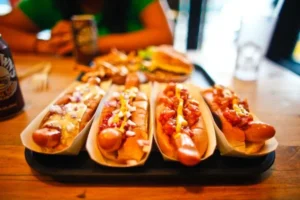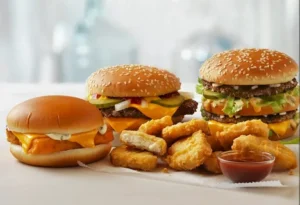In fast food, logos are a powerful tool used to attract customers. It makes them crave their favorite burgers, fries, and other fast food items.
From the golden arches of McDonald’s to KFC’s red and white stripes, these logos have become ingrained in our minds. Besides, they are instantly recognizable.
But what makes these logos so effective, and how do they influence our food choices?
The Power of Fast Food Logos
Fast Food Logos are more than just a visual representation of a brand. They are a way for companies to connect with consumers on an emotional level, creating a sense of familiarity and trust.
Studies have shown that consumers are more likely to choose a brand with a familiar logo over an unknown one. Besides, it makes sure the quality of the product is the same.
But fast food logos go beyond just familiarity. They are designed to trigger certain emotions and associations in our brains that make us crave the food they represent.
For Example
The McDonald’s logo’s bright red and yellow colors stimulate hunger and excitement. However, the green and white of Subway’s logo create a sense of health and freshness.

Subconscious Messages in Fast Food Logos
Fast food logos are also full of subtle messages and associations that we may not even be aware of. These messages can include everything from the shape and color of the logo to the fonts used in the brand name.
Here are some examples:
Arby’s Logo
It features a cowboy hat, which conveys a sense of ruggedness and masculinity.
Burger King’s Logo
It features bold, blocky letters, which suggest strength and stability.
KFC’s Logo
It is designed to look like a chicken, which creates a subconscious association with the food they serve.
Pizza Hut’s Logo
It features a roof-like shape, which suggests the idea of a cozy, warm environment.
These subtle messages may seem insignificant. However, they can have a powerful impact on our subconscious minds. Besides, it influences our food choices without us even realizing it.
The Evolution of Fast Food Logos
Fast food logos have evolved to keep up with changing trends and consumer preferences. Here are some examples of how some of the most iconic food logos have changed over the years:
McDonald’s
The original McDonald’s logo featured a simple black-and-white design with the company name and two arches. Over the years, the logo has evolved to include the iconic golden arches and the bright red and yellow color scheme.
Burger King
The original Burger King logo featured a cartoon king holding a hamburger. Today, the logo is much simpler, featuring bold block letters and a simple burger icon.
KFC
The original KFC logo featured a realistic image of Colonel Sanders. Today, the logo is more stylized, featuring a simplified image of the Colonel and the red and white stripes. It has become synonymous with the brand.
Subway
The original Subway logo featured the company name in plain font. Today, the logo features a stylized “S” and a green and white color scheme that has become synonymous with the brand.
The Future of Fast Food Logos
Fast food companies continue to adapt to changing consumer preferences and trends. Besides, we’ll see even more changes to fast food logos in the future. |

Here are some trends that may shape the future of food logos:
Minimalism
Many brands opt for simpler, more minimalist logos that are easier to recognize and remember.
Health and Wellness
As consumers become more health-conscious, we may see more food logos featuring greens and other healthy colors. Besides, it also shows more emphasis on fresh, natural ingredients.
Personalization
With the rise of technology, brands may offer more personalization. You can customize your logos according to your styles and choice.
Bottom Line
The power of fast food lies in their ability to trigger consumer cravings and familiarity. In addition, it ultimately drives sales and brand loyalty.
However, it’s important to remember that the quality of the food and customer experience should still be the main focus for these companies.







